Best Korean Sword Types and Their Historical Uses

What’s in this article?
Swords played a significant role in Korea’s history, as warriors struggled to fight invaders and maintain their nation’s independence. Korean swords were used for military and ceremonial purposes and widely varied in shape and design. Their designs were also influenced by the styles of neighboring China and Japan.
Let’s explore the different types of Korean swords, how the warriors used them, and what sets them apart from the Japanese samurai swords.
Most Popular Types of Korean Swords
Korean swords can be categorized into two broad types: the geom and do. Sometimes spelled as gum or kum, the term geom means sword, so all swords may be called geom. In sword typology, a geom often implies a double-edged blade, while a do is a single-edged weapon, though some exceptions exist. There are several types of Korean swords, but little is known about the individual types.
1. Hwandudaedo or Ring-Pommel Sword

The earliest type of Korean sword, the hwandudaedo, meaning ring-pommel sword, is often found in tombs from the Three Kingdoms era. It derived its name from the round shape of the pommel or daedo. The ornament inside the ring also reflected the social status of its owner. The dragon or phoenix symbols are considered auspicious creatures, implying that the owner might have been a nobleman.
The hwandudaedo came in various shapes and sizes, usually from 40 to 115 centimeters in length. There are also several subtypes based on their pommel decoration. Those without decorations are referred to as sohwandudaedo. There were also swords with three opened leaves called samyeophwandudaedo or three pommel rings forming a triangle called samruhwandudaedo.
2. Hwando
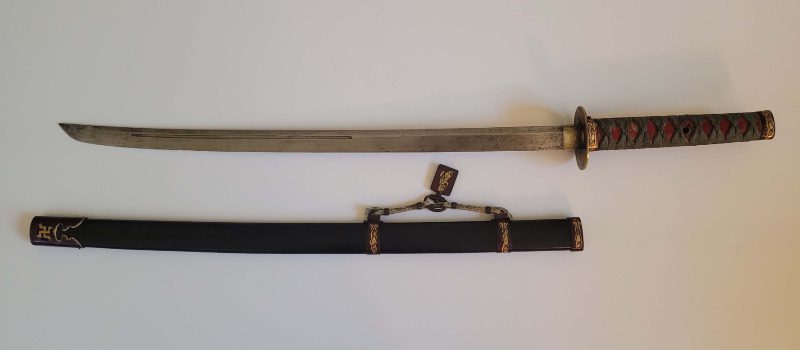
The traditional Korean sword of the Joseon dynasty, the hwando derived its name from the rings or hwan on the scabbard that allowed the cord to be tied around it. It was single-edged, typically straight or slightly curved, about 70 centimeters long.
During the time, the Korean army had to carry other weapons such as bows and arrows, so they preferred lighter swords. By the first Japanese invasion of Korea in 1592, hwando became as long as 90 centimeters, though it got shorter in the late Joseon era.
3. Ingeom or Tiger Sword
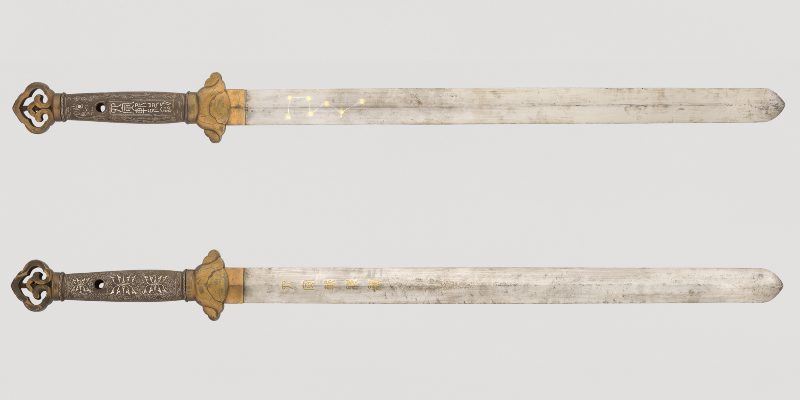
Made in the Year of the Tiger, the ingeom literally means tiger sword and was intended for ceremonial purposes rather than a battlefield weapon. During the Joseon era, from 1392 to 1910, the royal court believed that the sword could ward off evil, prevent calamities, and allow people to live in peace.
In Korean culture, the tiger embodies righteousness, so the ingeom was made to signify the need for the king and his subjects to fulfill their responsibilities. These swords were only produced when the astronomical cycle (zodiac) of the tiger appeared.
Sa-ingeom
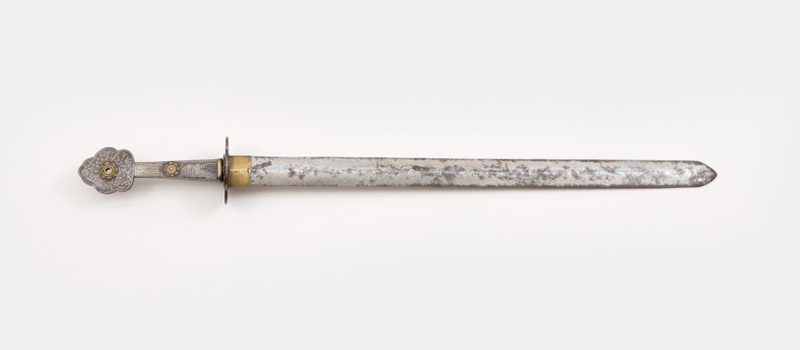
The term saingeom means four-tiger sword, a reference to swords produced when the sign of the tiger overlapped in four ways. Based on the lunar calendar, the swordsmiths produced the sword during the hour, day, month, and year of the tiger.
Sam-ingeom
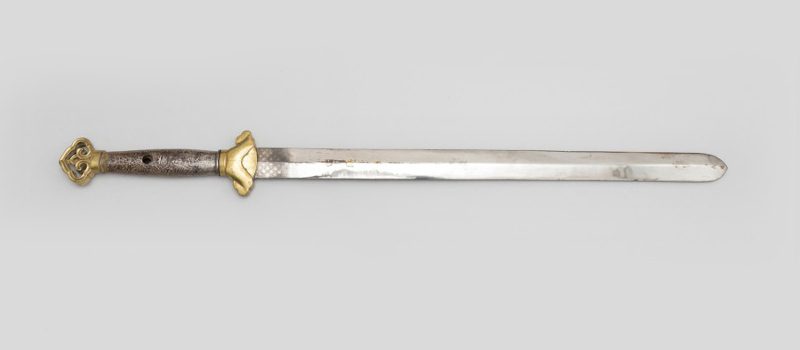
On the other hand, the samingeom means three-tiger sword, produced at a time of three overlapping tigers. The sa-ingeom or four-tiger sword was thought to be the strongest symbolic weapon, but the three-tiger sword was also a powerful weapon that warded off evil due to the sign of the tiger.
Characteristics of Korean Swords
There are many variations in the traditional Korean swords, but the hwando and tiger swords are perhaps the most popular for collectors.
Here are the unique characteristics of Korean swords:
Metal and Construction
Korea has a long history of swordmaking, but it was forgotten for a long time. Many traditional swordsmiths revive ancient swordmaking by mining iron ore, smelting iron, and forging it. Modern reproductions of Korean swords are crafted from high carbon steel, but if swordsmiths use modern steel, they cannot be called traditional.
Unlike military blades, the ceremonial tiger sword or ingeom required special materials. Swordsmiths used old iron to prevent corrosion, and they crafted the blade while making incantations with the aim of gathering auspicious energy. These swords were produced under strict conditions.
On the other hand, the Korean swords used in martial arts are often handmade by their owner. Unlike China or Japan, where swordsmiths crafted blades based on their set of standards and use, each Korean sword was developed to suit the swordsman who would use it. As a result, Korean swords varied greatly.
Blade Appearance
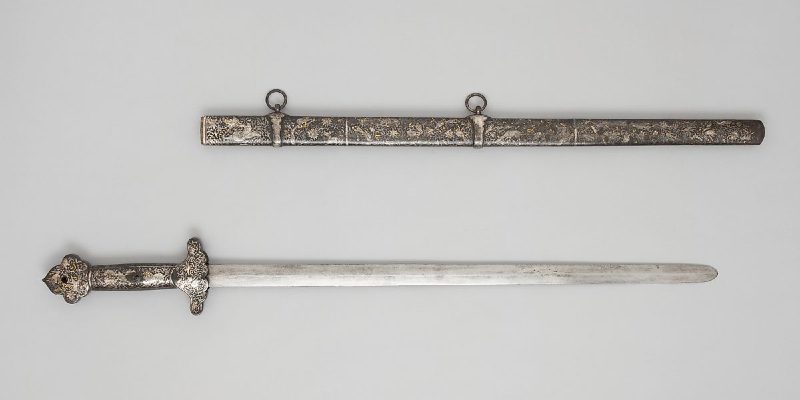
Some Korean swords have a straight, double-edged blade—similar to the Chinese straight sword jian but with a thicker heavier blade. The other popular designs are the straight or curved single-edged blades. The former could be narrow like Japanese swords or wide like Chinese swords.
Ingeom Blade Design
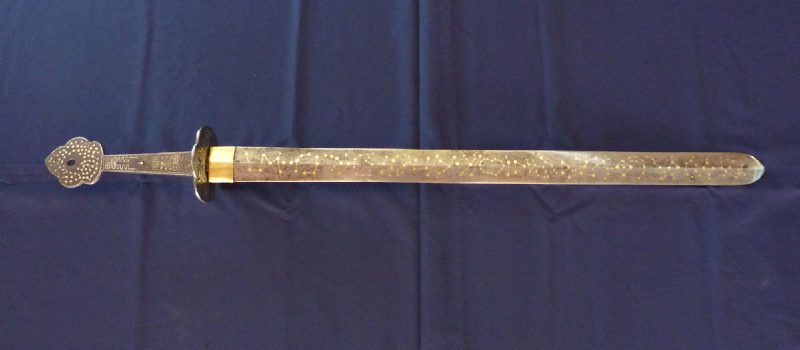
The ceremonial tiger sword often features decorative designs on the blade. One side of the blade often features the Big Dipper, a common motif on Korean, Chinese, and Vietnamese straight swords, as it was believed to have strong power to ward off evil. The other side of the blade usually features Sanskrit inscriptions that add to the talismanic property of the sword.
Hwando Blade Design
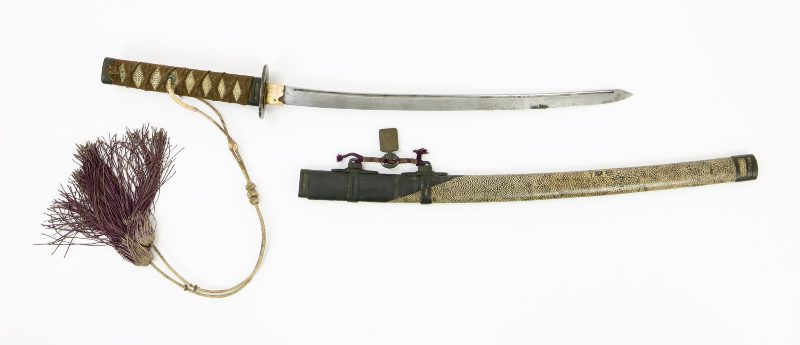
The hwando is a single-edged, slightly curved, or straight sword. Some versions of the sword resemble the Japanese katana, but its curvature does not follow a standard pattern. Some had fullers or blood grooves to lighten the blade, while others featured blade inscription.
Size and Length
Many Korean martial artists traditionally crafted their own swords, creating blades of all shapes and sizes. Sizes range from knife-like blades to long swords. While historical hwando ranged from 70 to 90 centimeters long, most tiger swords in museum collections are more than 100 centimeters long. Korean admiral Yi Sun-shin was famous for wielding the longest Korean sword, about a 195-centimeter long and 12-pound weapon.
Sword Mounting
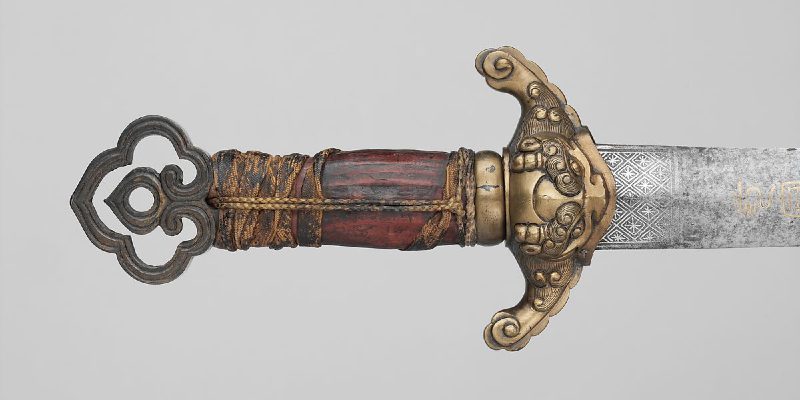
Korean sword mountings varied greatly, but martial artists often opt for hand guards large enough to protect the hand. Some swords are decorated with precious materials, making them artistically valuable.
Hilt
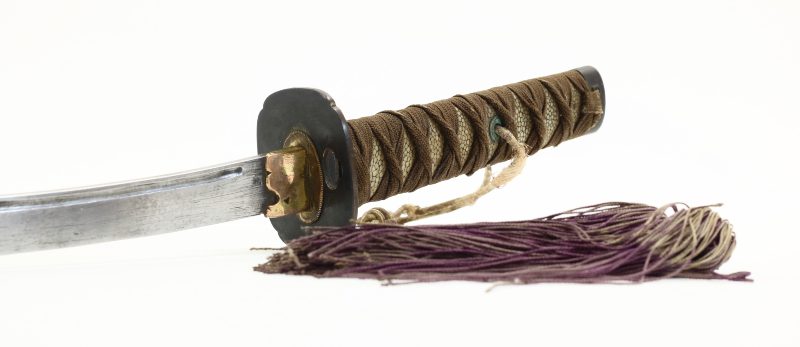
In ancient times, Korean swordsmen held their swords with both hands close together, but longer and heavier blades required a longer grip for added control. Hwando often had a wooden hilt wrapped with leather. In martial arts, practitioners could wield the swords with one or two hands. Some swords also feature a tassel decoration on the handle.
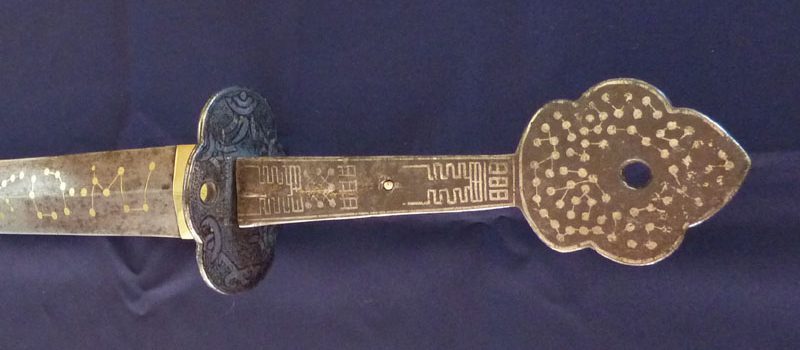
Ceremonial swords like sa-ingeom or four-tiger swords usually feature a large pommel designed with constellations found on celestial charts. Its hilt is often decorated with a talisman to ward off evil.
Sword Guard
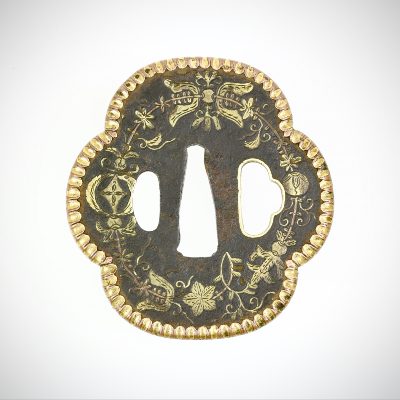
Joseon-era ceremonial sabers often had a mix of Chinese and Japanese design influences. Some Korean swords featured a sword guard similar to the Japanese tsuba. However, their hole openings, designed for the kozuka knife handle and kogai hairpin, were purely decorative. Korean culture did not copy the tradition of Japanese carrying the implements in the sword’s scabbard.

Some hwando completely lacked the openings on the sword guard but featured decorative design. On the other hand, ceremonial tiger swords had varied sword guard designs, from cloud-shaped to jian-like designs.
Scabbard

Scabbards also varied in material and design, as some hwando had lacquered scabbards while others had sharkskin covering. In ancient Korea, swordsmen carried their swords in their hands rather than wearing them on their belts as the Japanese samurai carried their swords. They also held their sword with the cutting edge facing down rather than facing up.
Palace guards wearing hwando often tied the scabbard to their attire and a bow on the top. When traveling, swordsmen often strapped their swords behind their back but were able to draw them quickly. When riding horseback, they usually wore their sword at the back of their waist. Some accounts say that generals who were close aides to the king used orange swords while ordinary warriors used black swords.
How much does a Korean sword cost?
In Korean martial arts, such as haedong gum do, practitioners use different training swords. A kagum, a dull practice sword, may range from around $250 to $700, depending if it has an aluminum or a heavyweight blade, usually determined by the instructor. A jingum, a real sword, may range between $800 to $2300, especially ones used in testing and competition.
Best Korean Sword Alternatives Online
The rarity of the Korean sword makes it more valuable and in high demand for museums and collectors. Some practitioners of Korean martial arts utilize swords like the Japanese katana and ninja swords as their alternative training weapons.
We rounded up the Korean sword alternatives to help you find the best training weapon and collection piece.
1. Best Overall: Clay Tempered Ninja Sword
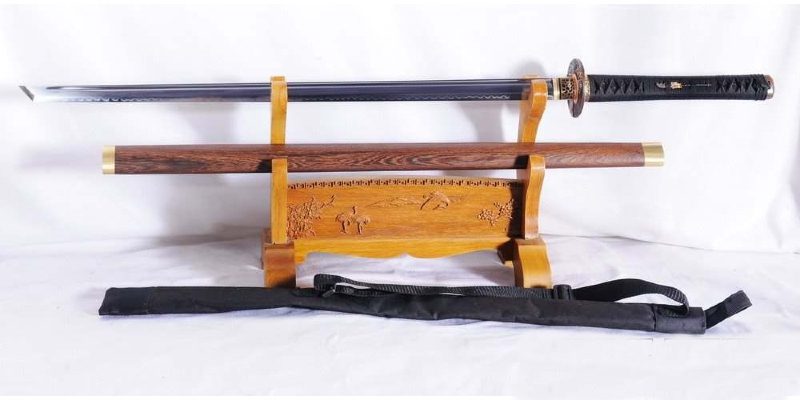
Korean practitioners usually use straight single-edged swords, making the ninjato the perfect alternative for training. This sword is crafted from 1095 high carbon steel, clay tempered, and suited for demonstration and test cutting practice. It has an overall length of 103 centimeters and a blade length of 70 centimeters.
Korean martial artists also prefer a rounded sword guard instead of the traditional square guard of the ninja sword. This ninjato comes with a relatively simple scabbard but features a decorative sword guard. For a budget of less than $400, you’ll have a high-quality training sword you can use not only in Korean martial arts, but also in ninjutsu.
2. Best Premium: Miyamoto Musashi Katana

Are you looking for a practice sword worthy as a collection piece? This katana features a single-edged, slightly curved blade, crafted from 1096 high carbon steel, and decorative mounting. For a budget of around $900, you’ll have a training sword suited for test cutting practice.
It will also let you channel your inner Miyamoto Musashi, a legendary swordsman of Japan who is also a popular character in anime, films, and television series. However, this katana sword comes with a sharp blade, so it is not the best option for cosplay and pop culture events.
3. Best on a Budget: Musha Katana Iaito

Korean martial artists use a dull practice sword kagum, making this iaito or blunt katana the perfect alternative. It features a 1045 medium carbon steel blade suitable for practicing cutting movements, drawing the weapon from scabbard, and sheathing the sword. It has a blunt blade, so it could also be ideal for choreographed sparring routines, sword dancing, and cosplay. For a budget of less than $70, you’ll have a sword for training and beyond.
Korean Swords vs. Japanese Swords
The sword used in Korean martial arts is known by several names, including hwando and jingum, which many consider the Korean version of the katana. Koreans who earned their black belt use a live blade called jingum, the equivalent of the Japanese word shinken or real sword. In Japanese iaido, practitioners use shinken, usually a sharpened katana, which can be modern or antique blades, depending on their resources.
Here are the notable differences between Korean and Japanese swords:
Blade Shape
The Japanese katana is always curved, but the historical hwando could be straight or slightly curved. Some Korean practitioners call their training sword jung kum, after the straight sword form called jung gum hyung. However, the term straight does not refer to the shape of the weapon, but to the action and movement of the practitioner.
Japanese blades often have a shinogi or ridge line along its entire length, but most Korean swords have none. Most of the time, the Korean jingum has thinner wider blades and is more lightweight than the katana—but some may also have heavier, thicker blades depending on the physical ability of the practitioner.
Sword Mounting
Traditional Japanese swords, especially the short sword wakizashi, usually have openings on the tsuba for kozuka and kogai. Some Korean sword guards have similar holes, but they are purely decorative. Korean swords usually have hardware to keep the blade in the scabbard. On the other hand, Japanese swords have the habaki, so the blade fits in the scabbard perfectly.
In Carrying and Drawing the Sword
While Korean swordsmen carried their sword with the cutting edge facing down, the samurai warriors wore their sword, particularly the katana, with the cutting edge facing up. Korean swordsmen generally drew their sword in a more defensive upward cut, but the samurai drew their katana and cut the enemy in one powerful action.
Korean Swords in Martial Arts
Korean swords are among the preferred weapons in traditional Korean martial arts, but many practitioners opt for the Japanese katana sword as Korean blades are hard to find.
Kumdo
Similar to Japanese kendo, kumdo is the popular Korean art of fencing. Practitioners train with a wooden sword called mokgum, sometimes spelled mok kum, identical to the Japanese bokken. They also use a bamboo sword called jukdo, similar to kendo’s shinai.
Haedong Gum Do
In haedong gum do, a Korean art of swordsmanship, practitioners use a jingum, a real sword, for test cutting, apart from the wooden and bamboo swords. Public demonstrations often show a quick rapid succession of cuts and slashes through a target, like bamboo or a bundle of straw. On the contrary, swordsmanship in Japan focuses on perfecting the single cut, as the first strike often distinguishes the winner from the loser.
Kuk Sool Won
One of the most popular systems in the world today, kuk sool won utilizes single or double swords. Many instructors and practitioners have learned ancient swordmaking and sword-wielding skills and created their own weapons based on the traditional Korean blades. Black belt practitioners use their swords for straight-line thrusting, chopping, and slicing.
Shim Soo Do
The Shim Soo Do, the Way of the Korean Sword, consists of drawing the weapon from a scabbard, cutting movements, and sheathing the sword. Practitioners use Korean straight swords with an oval handguard but sometimes utilize the ninja sword or katana sword as an alternative training weapon.
Other Types of Korean Swords
In South Korea, some organizations preserve the ancient Korean martial arts based on the 18th-century manual Muye Dobo Tongji, written under the order of King Jeongjo.
However, the romanized spelling of sword names may vary, as some are based on their literal meaning while others on their pronunciation. For instance, geom is the literal translation for sword, but gum is somehow how it is pronounced. Sometimes, kum is used instead of gum.
1. Ssang Soo Do (Long Sword)
Its original name is jang do and is referred to as pyung gum or yong gum. Its structure resembles a Japanese sword, but Chinese fencing influenced its techniques. More than six feet long, these two-handed sabers became popular in the late 16th and 17th centuries, when Japanese pirates used their odachi in plundering the Korean and Chinese coasts.
2. Ye Do (Short Sword)
Sometimes called dan do, the ye do was a short saber originally from China. It emerged when the soldiers along the borders needed a sword, short in length and had a thick back. Ironically, many sources describe it as four feet four inches long or about 132 centimeters long.
3. Ssang Gum (Twin Swords)
Both carried at the waist, ssang gum refers to double swords a warrior used together. He would typically use one for attack and the other for defense. Some also wielded the twin swords on horseback, referred to as masang ssang gum.
4. Wol Do (Crescent Sword)
Mainly considered a training weapon, wol do was a glaive or halberd, but described in Korean texts as a crescent sword. It had a long, broad blade attached to a staff-like handle, similar to the Chinese polearm guandao.
Its total length was seven feet, with its blade more than two feet long. During Japanese invasions, the warriors also wielded them from horseback, slashing their way through the most tightly packed formation of soldiers.
5. Hyup Do (Spear Sword)
Similar to the Japanese naginata polearm, hyup do is a type of glaive, but Korean texts describe it as a narrow-bladed spear sword. The warriors could have wielded them using techniques used in naginatajutsu, though they rarely used them in battles, as the weapons were not strong enough. They usually had a three feet long handle and weighed about 4 pounds.
History of the Korean Swords
Being surrounded by more powerful neighbor kingdoms, Koreans developed various swords, weapons, and art of warfare. They also adopted some of the fighting styles of neighboring China and Japan.
In the Three Kingdoms Period

From around 57 BCE to 668 CE, the country was divided into three kingdoms of Paekche, Goguryeo, and Silla. During the time, warfare consisted of foot soldiers with spears and archers on horsebacks. Most generals and leaders were also skilled swordsmen, and straight swords served as weapons for close quarters combat.
Swordmaking techniques were perfected in Korea and passed down from generation to generation. First Korean metal swords appeared in the writings from the Paekche dynasty, which had a strong trading relationship with Japan. Iron swords and swordmaking technology originated in China and then spread to Korea and Japan. The hwandudaedo or ring-pommel sword was similar to the so-called kanto-tachi mounting of the Japanese chokuto, which likely originated in the Korean peninsula.
The Korean Sword Arts
The Koreans favored the bow, so they did not develop sword arts to the same degree as Japan and China. During the Japanese period of occupation, from 1910 to 1945, Japan almost wiped out Korean culture and history, as all bladed weapons and indigenous martial arts were banned. Only a few martial arts masters preserved their art of swordmaking and passed it onto students.
The Japanese kendo was introduced in Korea, and by the 1920s, the name kumdo became popular among Korean martial artists. Chinese martial arts also influenced many Korean sword-fighting techniques, particularly those by Ming general Qi Jiguang, who established a system from the Japanese katana and its training methods.
The Korean Swordsmanship
Korean swordsmen wielded their swords with either one or two hands, depending on their need and strength. Two-handed techniques generally provided greater power. Still, a single-handed technique was efficient when a swordsman used his other hand, sometimes utilizing a scabbard, to block an enemy’s attack.
In ancient times, Korean swordsmen cut at the right angle and used enough speed to sever their enemies. A thin sharp sound indicated that the blade is correctly angled. On the contrary, a loud and heavy sound indicates a wrong angle or a movement too slow for an attack. Hence, modern-day swordsmen place emphasis on the sound their blades make as they cut through the air.
Conclusion
Korean swords come in many sizes and shapes, ranging from double-edged, straight swords to single-edged, curved blades. Unlike Japanese swords, they were designed strictly to fit the needs of their owners rather than following a traditional pattern. Like any weapon, Korean swords are highly efficient in the hands of skilled martial artists.




